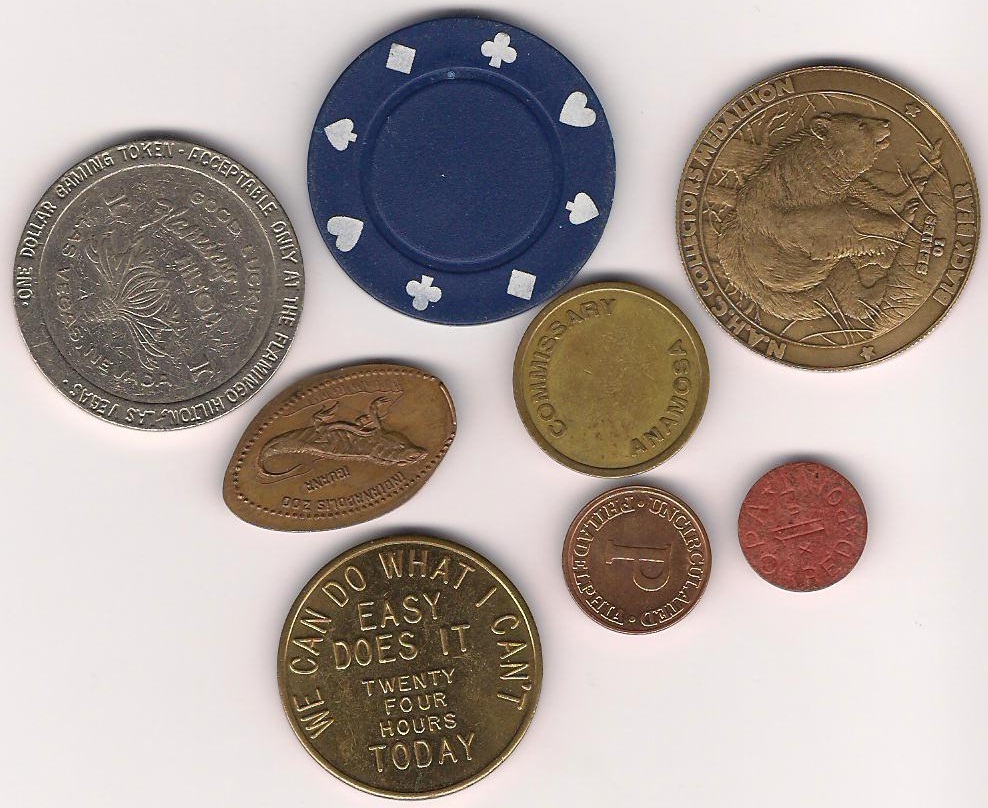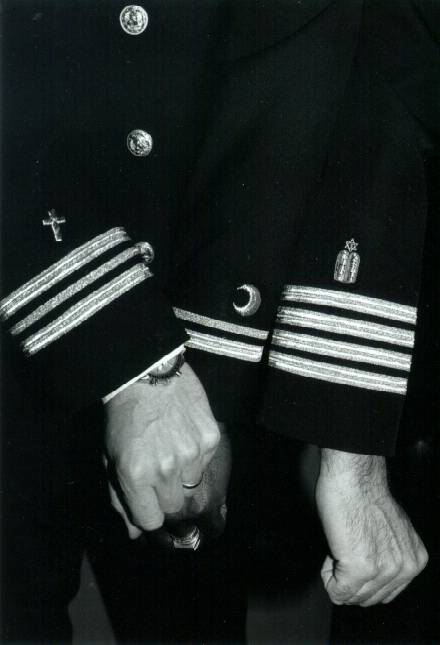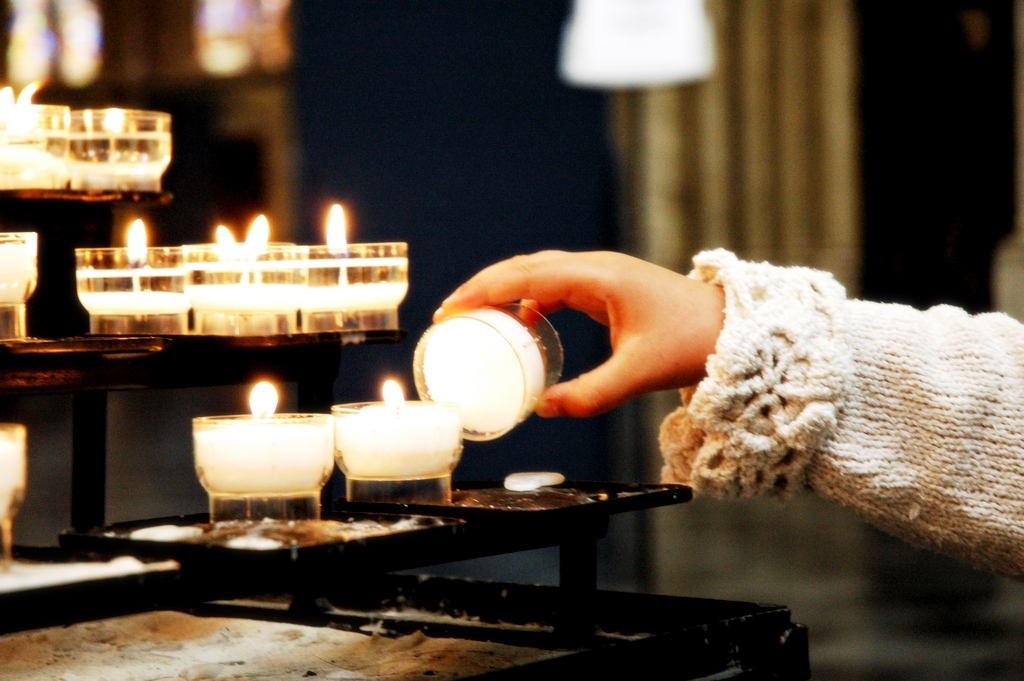|
Episcopal Church Service Cross
The Episcopal Church Service Cross (formerly called the Episcopal Church War Cross) is a pendant cross worn as a "distinct mark" of an Episcopalian in the United States Armed Forces. The Episcopal Church suggests that Episcopalian service members wear it on their dog tags or otherwise carry it with them at all times. History In 1917, the Episcopal Church created a War Commission to help serve the religious needs of Episcopalians in the U.S. military during World War I. Under the chairmanship of William Lawrence, Bishop of Massachusetts, the Commission supplied Episcopal chaplains with portable altars, vestments, prayer books, bibles, hymnals, and money for special assistance. The Commission decided that something more personal than service books should be given to Episcopalian troops as a reminder of their religious faith. The Commission requested that Edith Weir Perry, wife of the Bishop of Rhode Island, James DeWolf Perry, obtain designs for a cross or scapular. Mrs. Perry ... [...More Info...] [...Related Items...] OR: [Wikipedia] [Google] [Baidu] |
Cross Necklace
__NOTOC__ A cross necklace is any necklace featuring a Christian cross or crucifix. Crosses are often worn as an indication of commitment to the Christian faith, and are sometimes received as gifts for rites such as baptism and confirmation. Communicants of the Oriental Orthodox and Eastern Orthodox Churches are expected to wear their baptismal cross necklaces at all times, a practice derived from Canon 73 and Canon 82 of the Sixth Ecumenical Council (Synod) of Constantinople. Some Christians believe that the wearing of a cross offers protection from evil, while others, Christian and non-Christian, wear cross necklaces as a fashion accessory. "In the first centuries of the Christian era, the cross was a clandestine symbol used by the persecuted adherents of the new religion." Many Christian bishops of various denominations, such as the Orthodox Church, wear a pectoral cross as a sign of their order. Most adherents of the Ethiopian Orthodox Tewahedo Church will wear a cross ... [...More Info...] [...Related Items...] OR: [Wikipedia] [Google] [Baidu] |
Blessing
In religion, a blessing (also used to refer to bestowing of such) is the impartation of something with grace, holiness, spiritual redemption, or divine will. Etymology and Germanic paganism The modern English language term ''bless'' likely derives from the 1225 term , which developed from the Old English (preserved in the Northumbrian dialect around 950 AD).Barnhart (1995:73). The term also appears in other forms, such as (before 830), from around 725 and ' from around 1000, all meaning to make sacred or holy by a sacrificial custom in the Anglo-Saxon pagan period, originating in Germanic paganism; to mark with blood. Due to this, the term is related to the term , meaning 'blood'. References to this indigenous practice, Blót, exist in related Icelandic sources. The modern meaning of the term may have been influenced in translations of the Bible into Old English during the process of Christianization to translate the Latin term meaning 'to speak well of', resulting in me ... [...More Info...] [...Related Items...] OR: [Wikipedia] [Google] [Baidu] |
Exonumia
Exonumia are numismatic items (such as tokens, medals, or scrip) other than coins and paper money. This includes "Good For" tokens, badges, counterstamped coins, elongated coins, encased coins, souvenir medallions, tags, wooden nickels and other similar items. It is related to numismatics (concerned with coins which have been legal tender), and many coin collectors are also exonumists. Besides the above strict definition, others extend it to include non-coins which may or may not be legal tenders such as cheques, credit cards and similar paper. These can also be considered notaphily or scripophily. Etymology The noun ''exonumia'' is derived from two classical roots: ''exo'', meaning "out-of" in Greek, and ''nummus'', meaning "coin" in Latin (from Greek νοῦμμος – ''noummos'', "coin"); thus, "out ideof- he categoryoins". Usually, the term "exonumia" is applied to these objects in the United States, while the equivalent British term is paranumismatica. The words ''ex ... [...More Info...] [...Related Items...] OR: [Wikipedia] [Google] [Baidu] |
Religious Symbolism In The United States Military
Religious symbolism in the United States military includes the use of religious symbols for military chaplain insignia, uniforms, emblems, flags, and chapels; symbolic gestures, actions, and words used in military rituals and ceremonies; and religious symbols or designations used in areas such as headstones and markers in national cemeteries, and military ID tags ("dog tags"). Symbolism sometimes includes specific images included or excluded because of religious reasons, choices involving colors with religious significance, and "religious accommodation" policies regarding the wear of "religious apparel" and "grooming" (such as "unshorn" hair and beards worn for religious reasons) with military uniforms. Additionally, military chaplains themselves are sometimes regarded as "symbols of faith" for military personnel who face challenges to their faith and values. [...More Info...] [...Related Items...] OR: [Wikipedia] [Google] [Baidu] |
Episcopal Diocese Of The Armed Services And Federal Ministries
The Diocese of the Armed Forces and Federal Ministries in the United States is responsible for Episcopal Church (United States), Episcopal Church chaplains and their congregations in the U.S. Department of Defense, the U.S. Department of Veterans Affairs and the Federal Bureau of Prisons. Bishops * Arnold Lewis (1964−1971) * Clarence E. Hobgood (1971−1978) * Charles L. Burgreen (1978−1989) * Charles L. Keyser (1990−2000) * George Elden Packard (2000−2010) * James B. Magness, James B. "Jay" Magness (2010−2017) * Carl Wright (bishop), Carl W. Wright (2017−2022) The Rev. Ann Ritonia was elected in 2023 to serve as the next bishop, and will be consecrated in September 2023. [...More Info...] [...Related Items...] OR: [Wikipedia] [Google] [Baidu] |
Anglican Devotions
Anglican devotions are private prayers and practices used by Anglican Christians to promote spiritual growth and communion with God. Among members of the Anglican Communion, private devotional habits vary widely, depending on personal preference and on their affiliation with low-church or high-church parishes. Private prayer and Bible reading are probably the most common practices of devout Anglicans outside church. Some base their private prayers on the ''Book of Common Prayer''. Devotional practices among people and parishes who self-identify as Anglo-Catholic will naturally be different from those Anglicans who are Evangelical. Anglo-Catholics are likely to follow devotional customs familiar to the majority of Christians that have roots in the early and mediaeval periods as well as the contemporary form of devotion. These include daily prayer, particularly the Daily Office, and meditative and contemplative devotions hallowed by the centuries, e.g. the Rosary, the Stations of ... [...More Info...] [...Related Items...] OR: [Wikipedia] [Google] [Baidu] |
Book Of Common Prayer (1979)
The 1979 ''Book of Common Prayer'' is the official primary liturgical book of the U.S.-based Episcopal Church. An edition in the same tradition as other versions of the ''Book of Common Prayer'' used by the churches within the Anglican Communion and Anglicanism generally, it contains both the forms of the Eucharistic liturgy and the Daily Office, as well as additional public liturgies and personal devotions. It is the fourth major revision of the ''Book of Common Prayer'' adopted by the Episcopal Church, and succeeded the 1928 edition. The 1979 ''Book of Common Prayer'' has been translated into multiple languages and is considered a representative production of the 20th-century Liturgical Movement. Background Following the English Reformation and the separation of the Church of England from the Catholic Church, the liturgies of Anglicanism were transcribed into English. The first such production was the 1549 ''Book of Common Prayer'', traditionally considered to be work of ... [...More Info...] [...Related Items...] OR: [Wikipedia] [Google] [Baidu] |
Roman Numeral
Roman numerals are a numeral system that originated in ancient Rome and remained the usual way of writing numbers throughout Europe well into the Late Middle Ages. Numbers are written with combinations of letters from the Latin alphabet, each letter with a fixed integer value, modern style uses only these seven: The use of Roman numerals continued long after the decline of the Roman Empire. From the 14th century on, Roman numerals began to be replaced by Arabic numerals; however, this process was gradual, and the use of Roman numerals persists in some applications to this day. One place they are often seen is on clock faces. For instance, on the clock of Big Ben (designed in 1852), the hours from 1 to 12 are written as: The notations and can be read as "one less than five" (4) and "one less than ten" (9), although there is a tradition favouring representation of "4" as "" on Roman numeral clocks. Other common uses include year numbers on monuments and buildings and c ... [...More Info...] [...Related Items...] OR: [Wikipedia] [Google] [Baidu] |
Book Of Common Prayer
The ''Book of Common Prayer'' (BCP) is the name given to a number of related prayer books used in the Anglican Communion and by other Christian churches historically related to Anglicanism. The original book, published in 1549 in the reign of King Edward VI of England, was a product of the English Reformation following the break with Rome. The work of 1549 was the first prayer book to include the complete forms of service for daily and Sunday worship in English. It contained Morning Prayer, Evening Prayer, the Litany, and Holy Communion and also the occasional services in full: the orders for Baptism, Confirmation, Marriage, " prayers to be said with the sick", and a funeral service. It also set out in full the "propers" (that is the parts of the service which varied week by week or, at times, daily throughout the Church's Year): the introits, collects, and epistle and gospel readings for the Sunday service of Holy Communion. Old Testament and New Testament readings ... [...More Info...] [...Related Items...] OR: [Wikipedia] [Google] [Baidu] |
Eucharist
The Eucharist (; from Greek , , ), also known as Holy Communion and the Lord's Supper, is a Christian rite that is considered a sacrament in most churches, and as an ordinance in others. According to the New Testament, the rite was instituted by Jesus Christ during the Last Supper; giving his disciples bread and wine during a Passover meal, he commanded them to "do this in memory of me" while referring to the bread as "my body" and the cup of wine as "the blood of my covenant, which is poured out for many". The elements of the Eucharist, sacramental bread ( leavened or unleavened) and wine (or non-alcoholic grape juice), are consecrated on an altar or a communion table and consumed thereafter, usually on Sundays. Communicants, those who consume the elements, may speak of "receiving the Eucharist" as well as "celebrating the Eucharist". Christians generally recognize a special presence of Christ in this rite, though they differ about exactly how, where, and when Chr ... [...More Info...] [...Related Items...] OR: [Wikipedia] [Google] [Baidu] |
Obverse And Reverse
Obverse and its opposite, reverse, refer to the two flat faces of coins and some other two-sided objects, including paper money, flags, seals, medals, drawings, old master prints and other works of art, and printed fabrics. In this usage, ''obverse'' means the front face of the object and ''reverse'' means the back face. The obverse of a coin is commonly called ''heads'', because it often depicts the head of a prominent person, and the reverse ''tails''. In numismatics, the abbreviation ''obv.'' is used for ''obverse'',David Sear. ''Greek Imperial Coins and Their Values.'' Spink Books, 1982. p. xxxv. while ℞, )(Jonathan Edwards. ''Catalogue of the Greek and Roman Coins in the Numismatic Collection of Yale College, Volume 2.'' Tuttle, Morehouse & Taylor, 1880. p. 228. and rev.Allen G. Berman. ''Warman's Coins And Paper Money: Identification and Price Guide.'' Penguin, 2008. are used for reverse. In fields of scholarship outside numismatics, the term ''front'' is more com ... [...More Info...] [...Related Items...] OR: [Wikipedia] [Google] [Baidu] |
Crucifixion Of Jesus
The crucifixion and death of Jesus occurred in 1st-century Judea, most likely in AD 30 or AD 33. It is described in the four canonical gospels, referred to in the New Testament epistles, attested to by other ancient sources, and considered an established historical event. There is no consensus among historians on the details. Christopher M. Tuckett in ''The Cambridge companion to Jesus'' edited by Markus N. A. Bockmuehl 2001 Cambridge Univ Press pp. 123–124 In the canonical gospels, Jesus is arrested and tried by the Sanhedrin, and then by Pontius Pilate, who sentences him to flagellation and finally crucifixion by the Roman Empire.''The Cradle, the Cross, and the Crown: An Introduction to the New Testament'' by Andreas J. Köstenberger, L. Scott Kellum 2009 pp. 104–108Evans, Craig A. (2001). ''Jesus and His Contemporaries: Comparative Studies'' p. 316 Jesus was stripped of his clothing and offered vinegar mixed with myrrh or gall (likely posca ... [...More Info...] [...Related Items...] OR: [Wikipedia] [Google] [Baidu] |

.jpg)








